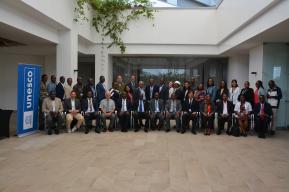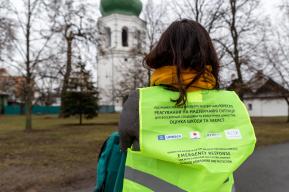News
Schoolchildren support scientists in the Gulf of Porto, France, as part of UNESCO’s Environmental DNA initiative

Under the spring sun and in the company of dolphins, thirteen young students from the Ota-Porto school, located near the Gulf of Porto: Calanche of Piana, Gulf of Girolata, Scandola Reserve UNESCO World Heritage site (France), contributed to the UNESCO Environmental DNA (eDNA) sampling campaign to improve scientific understanding of the site's unparalleled biodiversity.
Environmental DNA is an innovative scientific method that can be used to monitor and assess the biodiversity of the ocean without the need to extract organisms from their environment. A single liter of water can contain the genetic material of hundreds of species and can help determine the richness of the area's biodiversity.
Accompanied by UNESCO Director-General Audrey Azoulay, and under the supervision of scientific experts, their teacher and local managers, the schoolchildren took water samples from the UNESCO World Heritage site to extract environmental DNA using specialised filtering equipment provided by UNESCO.
The samples are expected to reveal the main species of fish that live in the area and are a key element of the Outstanding Universal Value of the Gulf of Porto: Calanche of Piana, Gulf of Girolata, Scandola Reserve.
The UNESCO eDNA campaign is being rolled out across 25 marine World Heritage sites between September 2022 and April 2023. The eDNA data is expected to provide a global one-off snapshot of biodiversity richness across UNESCO marine World Heritage sites, particularly for fish species.
Combined with Intergovernmental Panel on Climate Change (IPCC) heat scenario projections, the initiative will provide a first insight into how climate change might influence the geographic movements and distribution of fish species, which is critical for conservation decision-making.
Resulting data will be available at the UNESCO Ocean Biodiversity Information System, the world’s largest open science marine species database. Final results will be available in early 2024.
The UNESCO eDNA initiative is a joint collaboration between the Intergovernmental Oceanographic Commission and the World Heritage Centre. It is made possible with the support of the Government of Flanders (Kingdom of Belgium) and implemented in the context of the United Nations Decade of Ocean Science for Sustainable Development (2021-2030).
About the Gulf of Porto: Calanche of Piana, Gulf of Girolata, Scandola Reserve World Heritage site (France)
The Gulf of Porto: Calanche of Piana, Gulf of Girolata, Scandola Reserve was inscribed on the UNESCO World Heritage List in 1983 for its clear waters, with their islets and inaccessible caves, which are home to an extremely rich marine life. The nature reserve, which is part of the Regional Natural Park of Corsica, occupies the Scandola peninsula, an impressive, porphyritic rock mass. The vegetation is an outstanding example of scrubland. Seagulls, cormorants and sea eagles can be found there.









